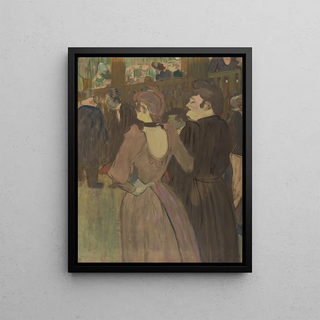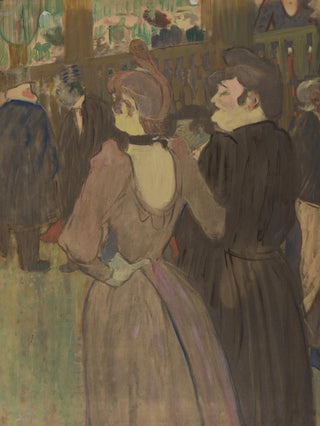Art print | La Goulue and Her Sister - Henri de Toulouse-Lautrec Source: Reproduction | La Goulue and Her Sister - Henri de Toulouse-Lautrec


View from behind

Frame (optional)
In the vibrant world of the Belle Époque, the artwork "La Goulue and Her Sister" by Henri de Toulouse-Lautrec stands out for its boldness and liveliness. This painting, emblematic of the Parisian cabaret scene, captures the very essence of an era where art and nightlife intertwine. The depiction of two dancers, including the famous Goulue, evokes not only the joy and excitement of evenings at the Moulin Rouge but also a certain melancholy, reflecting the aspirations and disillusions of a generation. Toulouse-Lautrec, with his sharp eye and unique talent, manages to infuse a soul into his characters, making them both accessible and profoundly human.
Style and uniqueness of the work
Toulouse-Lautrec's style is a fusion of impressionist techniques and daring compositions. In "La Goulue and Her Sister," he uses vivid colors and dynamic strokes to illustrate the movement and energy of the dancers. The slender silhouettes and graceful poses of the figures are highlighted by a minimalist background that focuses attention on the protagonists. This stylistic choice, characteristic of the artist, creates an atmosphere that is both festive and intimate, as if the viewer is a privileged spectator of a scene of life. The way he plays with light and shadow enhances the emotions of the characters, making their joy palpable while hinting at a certain fragility. This artwork is a perfect example of Toulouse-Lautrec's ability to capture the spirit of his time while remaining deeply rooted in the human experience.
The artist and his influence
Henri de Toulouse-Lautrec, born in 1864, is often regarded as one of the pioneers of post-impressionism. His work, marked by a unique sensitivity and innovative approach, has had a lasting impact on the art world. As an attentive observer of Parisian life, he was able to translate the social and cultural realities of his era with rare intensity. Toulouse-Lautrec's posters, paintings, and drawings testify to his commitment to marginalized subjects, notably cabaret artists and prostitutes.

Matte finish

View from behind

Frame (optional)
In the vibrant world of the Belle Époque, the artwork "La Goulue and Her Sister" by Henri de Toulouse-Lautrec stands out for its boldness and liveliness. This painting, emblematic of the Parisian cabaret scene, captures the very essence of an era where art and nightlife intertwine. The depiction of two dancers, including the famous Goulue, evokes not only the joy and excitement of evenings at the Moulin Rouge but also a certain melancholy, reflecting the aspirations and disillusions of a generation. Toulouse-Lautrec, with his sharp eye and unique talent, manages to infuse a soul into his characters, making them both accessible and profoundly human.
Style and uniqueness of the work
Toulouse-Lautrec's style is a fusion of impressionist techniques and daring compositions. In "La Goulue and Her Sister," he uses vivid colors and dynamic strokes to illustrate the movement and energy of the dancers. The slender silhouettes and graceful poses of the figures are highlighted by a minimalist background that focuses attention on the protagonists. This stylistic choice, characteristic of the artist, creates an atmosphere that is both festive and intimate, as if the viewer is a privileged spectator of a scene of life. The way he plays with light and shadow enhances the emotions of the characters, making their joy palpable while hinting at a certain fragility. This artwork is a perfect example of Toulouse-Lautrec's ability to capture the spirit of his time while remaining deeply rooted in the human experience.
The artist and his influence
Henri de Toulouse-Lautrec, born in 1864, is often regarded as one of the pioneers of post-impressionism. His work, marked by a unique sensitivity and innovative approach, has had a lasting impact on the art world. As an attentive observer of Parisian life, he was able to translate the social and cultural realities of his era with rare intensity. Toulouse-Lautrec's posters, paintings, and drawings testify to his commitment to marginalized subjects, notably cabaret artists and prostitutes.






